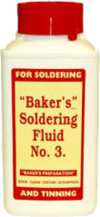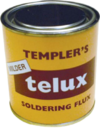Soldering Flux: Difference between revisions
From DT Online
mNo edit summary |
mNo edit summary |
||
| Line 18: | Line 18: | ||
{| | {| | ||
|- | |- | ||
| '''<dtamazon product="B002L5Y8R8" type="text">Multi-cored Solder</dtamazon>'''<br />Used extensively for electronics work, the solder has cores of [https://en.wikipedia.org/wiki/Rosin '''Rosin Flux'''] ''(aka Resin Flux)'' built in such that, when introduced to the heated work piece, both solder and flux flow together. [https://en.wikipedia.org/wiki/Rosin '''Rosin'''] has been in common use as an electronics flux. It is active as a flux above 70ºC, but below that temperature becomes a varnish with good insulating properties and is not corrosive. | | '''<dtamazon product="B002L5Y8R8" type="text">Multi-cored Solder</dtamazon>'''<br />Used extensively for electronics work, the solder has cores of [https://en.wikipedia.org/wiki/Rosin '''Rosin Flux'''] ''(aka Resin Flux)'' built-in such that, when introduced to the heated work piece, both solder and flux flow together. [https://en.wikipedia.org/wiki/Rosin '''Rosin'''] has been in common use as an electronics flux. It is active as a flux above 70ºC, but below that temperature becomes a varnish with good insulating properties and is not corrosive. | ||
| img align="right"|<dtamazon product="B002L5Y8R8" type="image">HQ Tind Solder 100 g</dtamazon> | | img align="right"|<dtamazon product="B002L5Y8R8" type="image">HQ Tind Solder 100 g</dtamazon> | ||
|- | |- | ||
Revision as of 12:10, 3 July 2017
Description
Fluxes are used generally to help molten metal flow and to shield its surface against the atmosphere to help prevent the formation of Oxides (e.g. during metal extraction or Smelting, and Casting). Fluxes are used for the same reasons when Soft Soldering or Hard Soldering plus, in addition, some may provide a cleaning function to actively remove surface Oxides which have already formed. Some of the earliest known Fluxes include Coke and Limestone as used in Blast Furnaces and animal fat or Tallow may have been used as long ago as in Ancient Rome.
Fluxes may be Passive, whereby their role is mainly protective, or Active in that they also, to a greater or less extent, clean the metal surface - usually by means of a corrosive acid. For this reason, Active Fluxes are not used when soldering electrical or electronic connections although some are mildly Active only above a certain temperature and form a useful insulating coating when cooled.
Note: After Soldering with an Active Flux (e.g. Baker's Fluid), the workpiece may need washing with Bicarbonate of Soda to neutralise the acid and halt further corrosion.
| Multi-cored Solder Used extensively for electronics work, the solder has cores of Rosin Flux (aka Resin Flux) built-in such that, when introduced to the heated work piece, both solder and flux flow together. Rosin has been in common use as an electronics flux. It is active as a flux above 70ºC, but below that temperature becomes a varnish with good insulating properties and is not corrosive. |
 |
| Bakers Fluid A water based flux containing Zinc Chloride and other salts commonly used for soldering and tinning of copper, brass and tinned materials. For most applications, the flux can be applied by brushing, this being the most convenient method of controlling where the flux is placed. Zinc Chloride containing fluxes are corrosive and flux residues should be removed as soon as possible after cooling by washing with water, preferably warm. |
|
| Fluxite Fluxite is a traditional grease paste flux used for Soft Soldering. It can be brushed onto the surfaces to be soldered and will also adhere to the solder stick prior to applying the heat. Fluxite is also Zinc Chloride activated and residues require removal when the soldering process is complete. |
 |
| Telux General purpose soldering flux suitable for Copper, Brass and Mild Steel. It is soft and easy to apply in a thin film and often used by Plumbers when making pipe joints for example. Telux is UK WRAS listed for use with both hot & cold water including potable water. It is also suitable for use with gas pipework. |
|
| Easy Flo Easy-flo Flux Powder can be used on all of the common engineering materials such as copper, brass, mild steel and stainless steel, but not aluminium. It is used extensively in Silver Soldering operations in which it is mixed with a little water then brushed along the joint prior to heating. |
 |
| SIF SIF-Flux is a fine powder mixture of borax and boric acid. These preparations are not considered hazardous, but do contain very mild irritants. SIF Bronze Brazing Flux Powder is for use on steel components being Brazed with a brass brazing alloy. Use by heating the brazing rod and dipping into the flux powder to coat it then bring both together to the heated metal |
|
| Borax Borax is used mixed with water as a flux for Silver Soldering and when soldering jewellery metals such as gold or silver. It allows the molten solder to flow evenly over the joint in question. It is commonly supplied as a Borax Cone and a rough surface earthenware dish on which it is ground with a little water to make a thin flux paste. |
 |
 |
 |
 |
 |
 |
 |
 |
 |
| Soldering Iron Station |
Multicore Solder |
LED Magnifier with Clamps and Soldering Stand |
Soldering Mat |
Soldering Flux |
Soft Solder |
Bakers Soldering Fluid |
Solder Flux Brushes |
Gas Soldering & Brazing Torch |
 |
 |
 |
 |
 |
 |
 |
 |
| LPG Gas Torch |
Gas Soldering & Brazing Torch |
Silver Solder Strip |
Easy-Flo Flux |
Borax Cone and Dish |
Brazing Rods |
Sifbronze Brazing Flux |
Iron Binding Wire |




